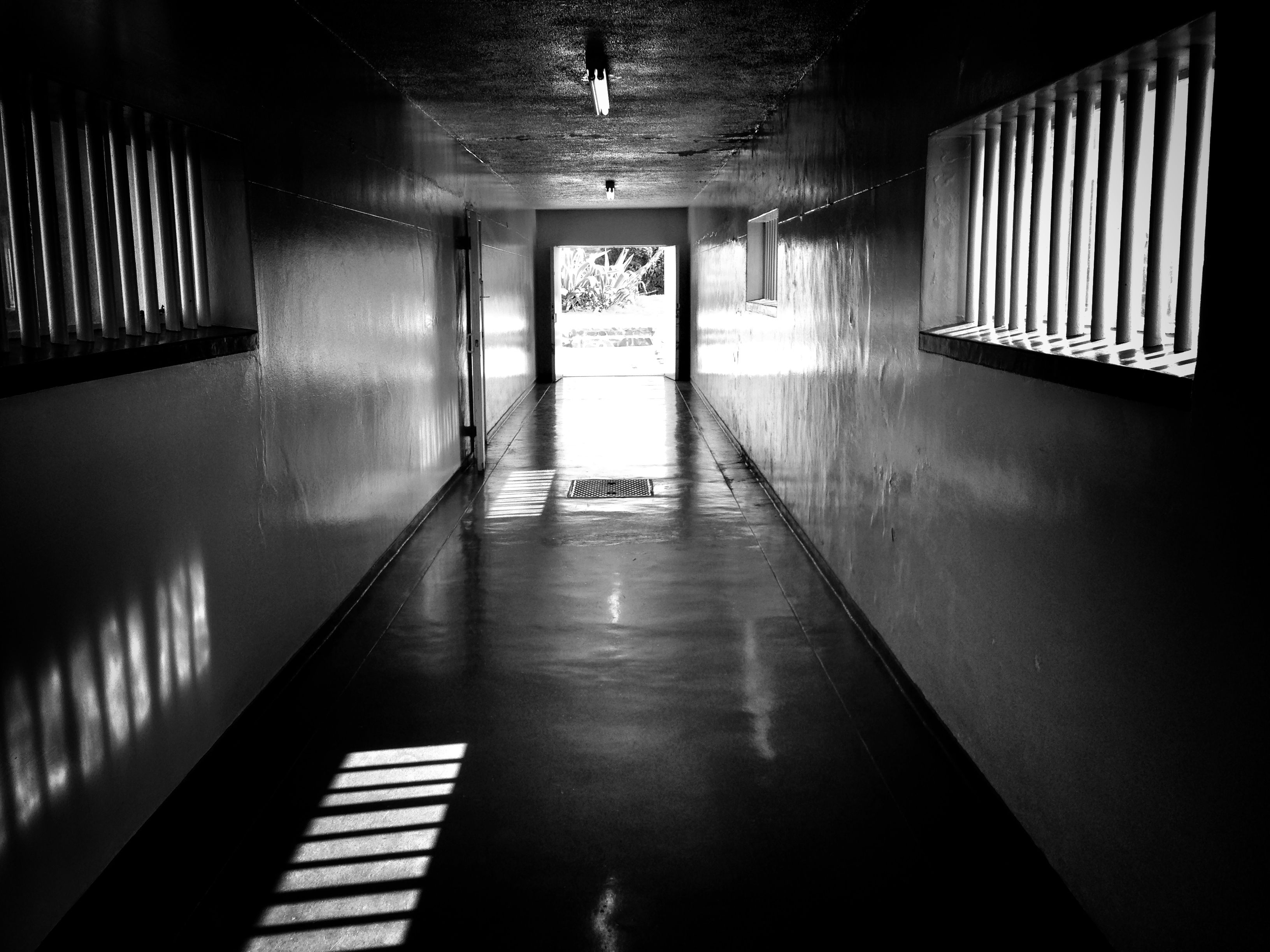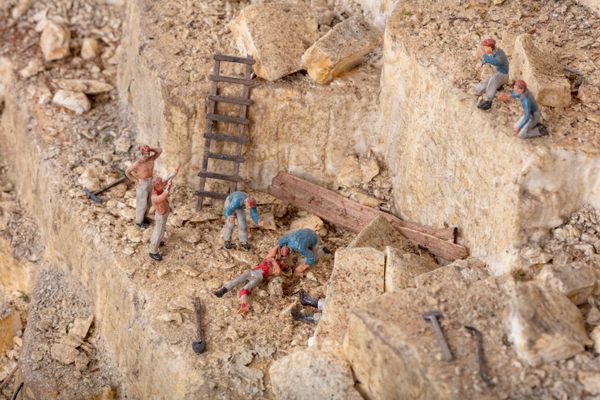From Apartheid-Era Inmate to Tour Guide—at the Same Prison
Thulani Mabaso spent six years in a cell at Robben Island. Now he’s back to show visitors around.

When Thulani Mabaso reflects on his six years at Robben Island prison, he thinks about the birds flying above him. During apartheid in South Africa, he along with inmates such as former presidents Nelson Mandela, Kgalema Petrus Motlanthe, and Jacob Zuma served terms ranging from six to 18 years at the notorious prison, which officially closed in 1996.
During his 2,190 days of incarceration, which ended in 1991, Mabaso had watched the Hartlaub gulls glide across the blue sky from his 8 foot by 7 foot jail cell, hoping he’d one day see them without bars in view. Now, he sees those birds every day as he ushers chipper tourists around the former prison turned museum.
On the bus tour, he points out the beautiful white lilies that inhabit this mostly submerged mountain juxtaposed with the limestone quarries where prisoners toiled rain or shine. As the tourists pass through the main gateway with the phrase “We Serve With Pride” at the top, Mabaso remarks on how the prisoners built the entrance in the 1960s out of malmesbury slate from the island’s quarry.

When they reach Mandela’s cell, he stops for a moment, and watches the tourists clamor around the historic site while posing for pictures. Posted in a neighboring cell is the prisoners’ original weekly food menu. Prisoners were given a set amount of food based on their skin color. Asians and prisoners of mixed backgrounds got better gruel than black Africans, but just barely. Everything and everyone was separate and unequal.
When the tour is over, and the tourists have returned to Cape Town, Mabaso sometimes walks around to take in the sights or meets with his former prison warden turned Robben Island Museum employee Christo Brand. “Mabaso was a natural leader, and I came to depend on him to mediate with a troublesome group of the political prisoners,” wrote Brand in his autobiography. Later in the book, he wrote that “between us, Mabaso and I achieved some peace. We became good friends…”
They are still good friends. They often have dinner and conduct prison museum tours together. It’s a cycle he’s grown accustomed to and enjoys, but it’s a far cry from how his life once was on this very island.

In the 1960s, Mabaso seethed with rage under the oppressive, dehumanizing apartheid rule. When he was eight years old, the government forcibly removed his family from their home in the northeast coastal province now known as KwaZulu-Natal to a crowded township. His family shared the asbestos-filled shanty house with eight other families. He slept on the floor with his grandfather, who later died of a stress-induced heart attack.
At 16 years old, Mabaso saw hope in anti-apartheid leaders like Mandela and Walter Sisulu, and quickly joined the Umkhonto we Sizwe (Spear of the Nation), the armed resistance of the African National Congress (ANC). With this group, he learned how to use AK-47s and explosives. He also learned the art of infiltration.
Mabaso got a job with the government-controlled South African Defence Force, and befriended many of the pro-apartheid co-workers who would soon be his targets. One Wednesday, he set off a mine bomb in the Defence Force building in Johannesburg. They didn’t see the attack coming. Fifty-seven people were wounded. In a 2013 interview, he said “I could have killed people, if I had wanted to. But our goal was to make a statement.”
Mabaso was 19 years old in 1983 when he was arrested on terrorism charges. While detained at John Vorster Square police station, he was waterboarded, given electric shocks while naked, and hung from a window. His interrogators threatened to drop him and claim he committed suicide. For his crimes, he was sentenced to 18 years in prison, three of which he spent at a Johannesburg prison. Then he arrived at Robben Island.

Wardens on the island were known for beating political prisoners, putting them in solitary confinement, forcing them to eat their own excrement, and other cruel forms of torture. In Robben Island’s brutality, however, Mabaso says he found a proud community and a new way to liberate himself and his country through education. “Robben Island prison was a real university,” says Mabaso. “Our slogan was very clear: ‘Each one for each one.’ We were very keen to help one another. We had our own career counseling.”
The pro-apartheid government sought to quell the anti-apartheid movement by sealing its activists away on a rocky island. But putting them in the same space emboldened their efforts.
With the help of Mandela, who by then had already been free for nearly a year, the ANC negotiated a deal with the then South African president F.W. De Klerk to release political prisoners. In 1991, Mabaso left a free man, and in 2002, five years after Robben Island Museum opened, he came back as a tour guide. He wanted to educate others about Robben Island’s brutal history, and prevent future atrocities.
It wasn’t easy. Everyday, he re-lived his trauma for tourists. The UNESCO heritage site suffered from mismanagement, corruption, and labor strikes. Some former prison guards, like Christo Brand, became tour guides, which added another emotional layer to his experience. “The wardens were so indoctrinated to believe that we were the most dangerous prisoners in the country, and that we wanted to take their country,” Mabaso says of his time in prison. “through the power of education and through our interaction, we were able to win some of them to be on our side, but it was kept secret all the time.” Brand and former captain James Gregory are a few examples.

According to Wesleyan professor Robyn Autry, the Robben Island tour is spatially designed to recreate the insular prison experience. Tourists come to the island via ferry, and then proceed with the bus and prison tour. From the quarries to Mandela’s cell, every movement is confined until the very end of the tour at an expansive dedication area. Autry says this museum sequence can be transformative for tourists. Tour guides who were formerly incarcerated are allowed to relate stories, but must follow government-approved guidelines on how to portray the prison. Most visitors are there to see Mandela’s cell and hear stories about him.
For Mabaso, spending time in the prison, though it’s now a tourist attraction, takes its toll. “The pain is existing still when I share with people,” he says. “Sometimes, I break out every other two minutes just to cool myself.”
Several psychological studies show revisiting and safeguarding traumatic places for generations can have rehabilitative effect on survivors. In the case of the Greek island of Ai Stratis, many political prisoners were exiled there from the 1920s until the 1960s under General Ioannis Metaxas’s military regime. Like with Robben Island, former exiles felt preserving this place of pain was instrumental for their healing. For Mabaso, however, that healing came gradually.

His commitment to keeping Robben Island’s memories alive helped him move forward. “We need to rewrite our history so former inmates come and interact with visitors and re-educate our children about the history of the country,” he says.
There’s a somewhat brighter side to seeing the island differently. Mabaso gets to look at the white lilies and Springbok antelopes that he could never see or touch. He used to think of the ocean as a 6-kilometer swim to freedom. Now, it’s just an ocean. While taking visitors on tours of his former daily struggles is painful, he hopes releasing his story out to the world will make people take action against institutionalized racism. “I am very pleased that I am still alive to see these days,” he says. “There are comrades who never see this day. For those who are still alive let us use our days properly.”
























Follow us on Twitter to get the latest on the world's hidden wonders.
Like us on Facebook to get the latest on the world's hidden wonders.
Follow us on Twitter Like us on Facebook